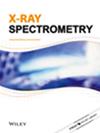用全反射x射线荧光和电感耦合等离子体光学发射光谱法定量膳食补充剂中的元素
IF 1.5
4区 物理与天体物理
Q3 SPECTROSCOPY
引用次数: 0
摘要
摘要本研究的主要目的是比较微波辅助湿消化(MAWD)和悬浮液制备两种不同样品制备方法所获得的定量结果。用两台装有Mo x射灯管的全反射x射线荧光(TXRF)光谱仪比较了两种不同样品制备途径的结果,并进一步与传统的电感耦合等离子体发射光谱(ICP - OES)分析方法(包括MAWD)进行了比较。对三种不同元素含量和浓度的膳食补充剂样品进行了分析。强调了简化样品制备路径的优点和局限性。讨论了TXRF和ICP - OES之间的循环试验。准确度为所有测量的回收率百分比,范围从80到120。所有结果的精密度TXRF不超过8%,ICP‐OES不超过5%。不同元素的TXRF定量限为1 ~ 0.01 mg/丸。结果表明,样品的悬浮液制备可能是对膳食补充剂质量控制需求日益增加的一种有用的反应,因为它耗时少,成本效益高。本文章由计算机程序翻译,如有差异,请以英文原文为准。
Quantification of elements in dietary supplements by total reflection x‐ray fluorescence and inductively coupled plasma optical emission spectrometry
Abstract The main purpose of this study was the comparison of the results of quantification obtained via different sample preparation approaches such as microwave‐assisted wet digestion (MAWD) and suspension preparation. Two total reflection x‐ray fluorescence (TXRF) spectrometers equipped with Mo x‐ray tubes were used to compare results obtained via two different paths of sample preparations which would further be compared to the conventional way of analysis by inductively coupled plasma optical emission spectrometry (ICP‐OES) including MAWD. Three dietary supplement samples with different sets and concentrations of elements were analyzed. The benefits and limitations of the simplified path of sample preparation were highlighted. A round‐robin test between TXRF and ICP‐OES was discussed. Accuracy as the percentage of recovery in all measurements ranged from 80 to 120. Precision for all results did not exceed 8% for TXRF and 5% for ICP‐OES. Limits of quantification by TXRF are ranged from 1 to 0.01 mg/pill for different elements. It was shown that suspension preparation of samples might be a useful response to increasing demand for quality control of dietary supplements since it is less time consuming and cost efficient.
求助全文
通过发布文献求助,成功后即可免费获取论文全文。
去求助
来源期刊

X-Ray Spectrometry
物理-光谱学
CiteScore
3.10
自引率
8.30%
发文量
38
审稿时长
6-12 weeks
期刊介绍:
X-Ray Spectrometry is devoted to the rapid publication of papers dealing with the theory and application of x-ray spectrometry using electron, x-ray photon, proton, γ and γ-x sources.
Covering advances in techniques, methods and equipment, this established journal provides the ideal platform for the discussion of more sophisticated X-ray analytical methods.
Both wavelength and energy dispersion systems are covered together with a range of data handling methods, from the most simple to very sophisticated software programs. Papers dealing with the application of x-ray spectrometric methods for structural analysis are also featured as well as applications papers covering a wide range of areas such as environmental analysis and monitoring, art and archaelogical studies, mineralogy, forensics, geology, surface science and materials analysis, biomedical and pharmaceutical applications.
 求助内容:
求助内容: 应助结果提醒方式:
应助结果提醒方式:


